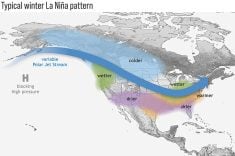Crop breeders are coming off a production year that mirrored what happened in the farming community at large – for some it was fruitful, for others a complete disaster.
Wet weather created ideal conditions for disease development at many of the University of Saskatchewan Crop Development Centre’s nine research sites in the province.
And that’s a good thing when you’re looking for lines that stand up to fungal diseases, said pulse crop breeder Bert Vandenberg.
The centre’s lentil breeding program took big strides in determining which experimental lines are better suited to resisting diseases like ascochyta, anthracnose, botrytis and especially sclerotinia.
Read Also

Canadian Food Inspection Agency extends chronic wasting disease control program consultation deadline
Date extended for consultation period of changes to CWD program
“We’re maybe on to something. We’ve got some breeding lines that for whatever reason seem to tolerate (sclerotinia) more,” said Vandenberg.
Breeders were also able to screen for mycosphaerella blight resistance in peas and to get a read on the best early maturing lines of chickpeas and beans, varieties that fared well despite below average heat units.
It was a relief to have a productive season of data gathering after successive years of drought when not much information was gleaned.
Vandenberg was pleased with the wide range of weather conditions at the research sites. While most plots were cool and wet, some had hot and dry conditions.
“Typically if we find advanced breeding lines that do well over the whole range of environments, they’re usually pretty good ones,” he said.
Things weren’t as cheery one province over where the five wheat and oat breeders working out of Agriculture Canada’s Cereal Research Centre in Winnipeg had one of the worst research seasons in memory.
Only 15 percent of the centre’s yield trials and disease nurseries were seeded before a May 11 snowstorm that ushered in a period of wet weather that kept researchers off their plots until June 10.
“We had an awful lot of late material,” said wheat breeder Doug Brown.
Another unusual spell of wet weather provided a fitting bookend to the disastrous crop year. About two-thirds of the yield trials at the main 250-acre Glenlea research site remain unharvested. Brown said there’s not much point in taking off the experimental wheat and oat crops to assess for quality or yield performance.
“After you’ve had four to six weeks of rain on it, what’s the point?”
In his 30 years of research he has never seen so much moisture at harvest time. With water running in the ditches, it looked more like spring than fall. What little harvesting took place was done by sickle instead of combine.
“There was one week in which we were wearing rubber boots. We were collecting heads because the wheat was standing up yet we were walking in water.”
Brown said a complete write-off like 2004 is disheartening because breeders have a limited amount of time to get “their babies” released as new varieties.
“You have to make every year count.”
To top it off, the seed needed for next year’s co-op trials was destroyed by frost at Indian Head, Sask., and Regina, where it was being multiplied.
The centre shipped breeder seed to New Zealand so it can be multiplied over the winter to provide enough for next year’s research trials.
Seed supplies of elite Agriculture Canada lines destined for commercialization were also decimated by frost at the two Saskatchewan locations, which means a delay in getting new varieties into farmers’ hands.
“It was a terrible year, just a terrible year,” said Brown.















